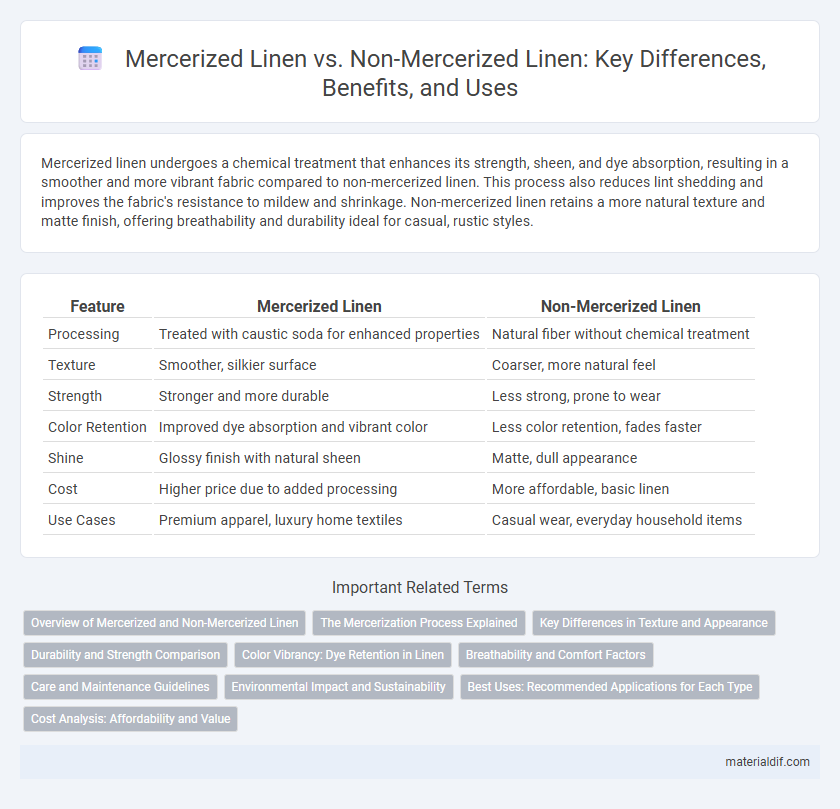Mercerized linen undergoes a chemical treatment that enhances its strength, sheen, and dye absorption, resulting in a smoother and more vibrant fabric compared to non-mercerized linen. This process also reduces lint shedding and improves the fabric's resistance to mildew and shrinkage. Non-mercerized linen retains a more natural texture and matte finish, offering breathability and durability ideal for casual, rustic styles.
Table of Comparison
| Feature | Mercerized Linen | Non-Mercerized Linen |
|---|---|---|
| Processing | Treated with caustic soda for enhanced properties | Natural fiber without chemical treatment |
| Texture | Smoother, silkier surface | Coarser, more natural feel |
| Strength | Stronger and more durable | Less strong, prone to wear |
| Color Retention | Improved dye absorption and vibrant color | Less color retention, fades faster |
| Shine | Glossy finish with natural sheen | Matte, dull appearance |
| Cost | Higher price due to added processing | More affordable, basic linen |
| Use Cases | Premium apparel, luxury home textiles | Casual wear, everyday household items |
Overview of Mercerized and Non-Mercerized Linen
Mercerized linen undergoes a chemical treatment with caustic soda that enhances its strength, luster, and dye absorption compared to non-mercerized linen, which retains a more natural, matte finish with a coarser texture. The mercerization process improves the fabric's smoothness and resistance to shrinking, making mercerized linen more suitable for high-end apparel and luxury bedding. Non-mercerized linen maintains superior breathability and moisture-wicking properties, favored for casual wear and eco-friendly home textiles.
The Mercerization Process Explained
Mercerization is a chemical treatment that involves soaking linen fibers in a caustic soda solution to increase their strength, luster, and affinity for dyes. This process causes the fibers to swell, resulting in a smoother surface that reflects light more effectively, enhancing fabric sheen and color vibrancy compared to non-mercerized linen. Mercerized linen also exhibits improved moisture absorption and durability, making it a premium choice for high-quality textiles.
Key Differences in Texture and Appearance
Mercerized linen features a smoother, shinier texture due to the chemical treatment that strengthens and enhances the fibers, giving it a lustrous and vibrant appearance. Non-mercerized linen retains its natural, more matte finish with a coarser and slightly rough texture that emphasizes its rustic and organic look. The mercerization process increases linen's sheen and dye absorption, resulting in richer color intensity compared to the more muted tones of non-mercerized linen.
Durability and Strength Comparison
Mercerized linen undergoes a chemical treatment that enhances fiber strength and increases durability, making it more resistant to wear and tear compared to non-mercerized linen. This process realigns fibers, resulting in improved tensile strength and longevity, which is particularly beneficial for upholstery and high-use textiles. Non-mercerized linen, while naturally strong, lacks this reinforced structure, leading to comparatively lower resistance against abrasion and less overall durability.
Color Vibrancy: Dye Retention in Linen
Mercerized linen undergoes a chemical treatment that enhances its dye absorption, resulting in significantly more vibrant and long-lasting colors compared to non-mercerized linen. This process increases fiber smoothness and reduces porosity, allowing dyes to penetrate deeper and resist fading over time. Non-mercerized linen retains color less effectively, often displaying duller shades and quicker fading with washing and exposure to sunlight.
Breathability and Comfort Factors
Mercerized linen undergoes a chemical treatment that enhances fiber strength, resulting in improved durability and a smoother texture compared to non-mercerized linen. Despite this process, mercerized linen maintains excellent breathability, allowing air circulation that helps regulate body temperature and wick moisture effectively. Non-mercerized linen typically offers a slightly more rustic feel but remains highly breathable and comfortable, making both types suitable for warm climates and sensitive skin.
Care and Maintenance Guidelines
Mercerized linen offers enhanced luster and strength, making it more resistant to shrinkage and easier to maintain compared to non-mercerized linen. For care, mercerized linen can withstand higher washing temperatures and frequent laundering without losing vibrancy, while non-mercerized linen requires gentler washing cycles and cooler water to prevent damage. Both types benefit from air drying and ironing at medium heat, but mercerized linen generally demands less delicate handling for long-lasting quality.
Environmental Impact and Sustainability
Mercerized linen undergoes a chemical treatment that enhances fiber strength and sheen but typically involves higher water and energy consumption, impacting its overall environmental footprint compared to non-mercerized linen. Non-mercerized linen preserves the natural qualities of flax fibers with minimal processing, promoting better biodegradability and lower carbon emissions during production. Sustainable linen choices often prioritize non-mercerized fabric due to its reduced chemical usage and alignment with eco-friendly textile manufacturing practices.
Best Uses: Recommended Applications for Each Type
Mercerized linen, known for its enhanced luster, strength, and smooth texture, is ideal for high-end apparel, luxury bedding, and decorative textiles where a polished finish is desired. Non-mercerized linen, with its natural matte appearance and breathable qualities, suits casual clothing, summer garments, and home textiles like tablecloths and curtains that prioritize comfort and durability. Choosing between mercerized and non-mercerized linen depends on whether the application demands elegance and sheen or rustic charm and practicality.
Cost Analysis: Affordability and Value
Mercerized linen undergoes a chemical treatment that increases its strength, luster, and dye affinity, which elevates its production cost compared to non-mercerized linen. Non-mercerized linen remains more affordable due to a simpler manufacturing process, appealing to budget-conscious consumers seeking natural texture over sheen. The higher upfront cost of mercerized linen often justifies its long-term value through enhanced durability and vibrant color retention, making it a cost-effective choice for premium textile applications.
Mercerized Linen vs Non-Mercerized Linen Infographic

 materialdif.com
materialdif.com